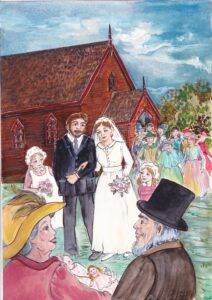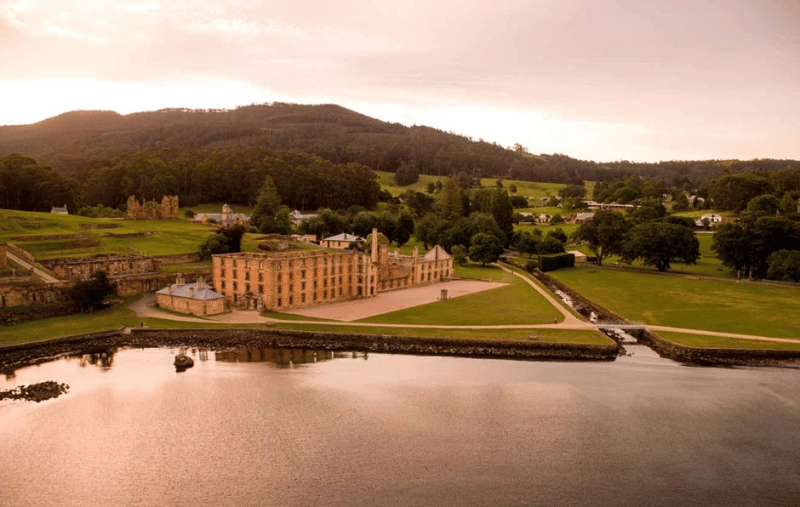Chapter Ten Ann’s Story -The Ewingtons
Ann’s Story -The Ewingtons
Coming Soon
Deloraine
The Ewingtons moved to Deloraine soon after their marriage as Joseph (great-grandfather) was born at Deloraine in November 1849. They were part of the migration west, to land that was becoming available on the North-west Coast of Van Diemen’s Land. John is listed as a labourer from 1849 until 1853 when he becomes known as a farmer. My hunch is they wanted a fresh start and initially became workers on one of the larger estates near Deloraine. At about the same time, George and Elizabeth Smith, Ann’s sister, also move to Deloraine. Fortunate as Ann’s seventh and John’s second child Sarah was born in January 1851.
In 1851 John was aware his father Joseph was found guilty of selling stolen vegetables in Westbury, selling them in Deloraine, and sentenced to the Cascades Workstation for 18 months of hard labour. Joseph’s Digswell habits did not change. He died a lonely old man at the station.
Unfortunately, making a fresh start in Van Diemen’s in the 1850’s often meant denying your past to the point some shunned their parents. John may well have been pleased Joseph was no longer in the district.
In 1853 the Ewingtons purchased ten acres from Samuel Morse for 91 pounds, a considerable sum for them. How they found the money is an interesting story showing their resolve and resilience. John along with Ann’s eldest son Charles left the colony onboard the Yarra Yarra, in September 1852. The Yarra Yarra, a passenger and cargo ship servicing the rapidly expanding Gold Fields sailed between Launceston and Sydney via Melbourne. My strong hunch is John and Charles were two of the 19000 Van Demonians who headed for the goldfields in the 1850’s. John didn’t make a fortune but earned enough to buy ten acres from Morse in June 1853.
This adventure provides insight into John’s transformation from a petty thief in Digswell, Hertfordshire to a responsible adult. Navigating the hurly-burly of the goldfields and Melbourne in the 1850s was not for the faint-hearted, but John managed it quite well. Mischievously Ann may well have strongly suggested Charles go with John to be a moderating influence. Whatever, she trusted John enough to allow Charles to go on what must have been an eye-opening adventure.
Ann then, was left to care for six young children on her own for at least four months. Ann had already shown she coped well under the most difficult circumstances but having sister Elizabeth nearby helped. She worked from daylight to dark and then some. Now the Ewingtons were landowners John could vote – a privilege Ann would have to wait another 44 years to attain. The times were stunningly different.
In 1854, John met a substantial test of character. Detective Maguire charged Benjamin Shadbolt with the theft of John’s horse. The case was dismissed as John could not identify the horse. Benjamin and John were convicted serial thieves from Hertfordshire and knew one another well. It raises questions about why great-great-grandfather John could not recognize his mouse-colored horse. One interpretation is he passed the test of character by not dobbing in his mate. Another is Benjamin may well have coerced John not to identify the horse.
I suspect however that much like George Shadbolt, John was not at all concerned when Benjamin emigrated to New Zealand after serving time in Port Arthur for theft. In 1856 Van Diemen’s land was renamed Tasmania and collectively Tasmanians tried to deal with their past by just forgetting about it. The Ewingtons like the Shadbolts of Sassafras wanted to forge a new life without the stain of convictism holding them back. Benjamin was not helping.
In the late 1850s, John and Ann expanded their farming operations. They retained the Morse property and occupied 80 acres owned by Mr. T.W. Field, a speculative landowner near Deloraine. This move was essential for John and Ann as their family continued to grow. Rebecca was born in 1854, Emily in August 1856, Thomas in December 1858, and Mary in December 1861. A total of 11 children 10 of whom are living at home. The oldest Charles married Jane Carey at Deloraine in 1859.
John and Ann while having a large family also had a workforce. Their children completed chores from a very early age. In the late 1850’s at least Charles, Ann, Henry, John, William, Joseph, Sarah, and possibly Rebecca, were carrying water from wells or rivers, washing dishes, helping with the laundry, gathering wood, feeding chickens, and gathering their eggs, and milking the cows. The girls also helped Ann with knitting and sewing, washing and ironing clothes, cooking, cleaning, and making beds. The boys helped John by chopping wood, caring for animals, and doing various farm tasks. The Ewington children had a short childhood, not unusual for the time, they worked like adults from as soon as they were able, but they also found time to play.
The Deloraine phase of John and Ann’s life ended in c.1865. It was a successful phase; the children were well looked after and happy. They were accumulating money and wanted a larger property of their own. They purchased 125 acres from MR W.H. Clayton, a speculative landowner, at Green Creek Road East Sassafras in 1865. They sold their Deloraine property to James Bennett on the same day. The Green Creek farm is part of the present-day Spring Hill property
Sassafras
The family, or some of the family, moved to the property before the sale was complete. Ann’s last child Ellen, born in October 1864, was registered in the Port Sorrel district which included Sassafras. I doubt much of the property had been cleared as Sassafras was not settled until the late 1850’s. There must have been, however, some type of house or hut to shelter the family. So, John and Ann and their family workforce started again, this time on their own property.
The Ewingtons are remembered as pioneer farmers of Sassafras. Despite some family tragedies, the Sassafras era was a golden time for the Ewingtons. They became an accepted part of the Wesleyan community and involved themselves in community events while developing a mixed farm. Further, for Ann in particular, her childbearing years were over, and her older children started to marry and move on.
The Ewingtons were now within walking distance of the emerging town of Sassafras. I have no doubt they needed the services of Geroge Shadbolt’s blacksmith shop. Recalling John Ewington and George Shadbolt knew one another, albeit in vastly different circumstances, in Hertfordshire, England, the families soon formed a new friendship.
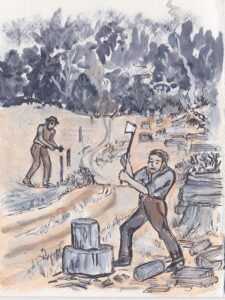
In 1865, Henry Keep, Ann’s second child married Sarah Carey at the Weslyn Chappel, Sassafras and George Shadbolt was a witness. Sarah Ewington married Isaac Lunson also in the Weslyn Chapel in 1869. Unfortunately, their daughter Rebecca, aged 15, died in 1869 of hepatitis and or pleurisy. So, it was a time of family celebrations and sadness.
The Ewington conversion to the Weslyen ways was not as profound as the Shadbolts but I am sure they attended family gatherings held after church services at the Shadbolt Blacksmith Shop. The Ewington children went to the new Sassafras school and learned to read and write. They were hard times by 21st-century standards, but they were good times. The Ewingtons arrived when Sassafras was growing, and community facilities were being built with the help of volunteer labour.
During the Gold Rush, the demand for Tasmanian timber and farm produce surged. Ewington wheat and timber products were shipped to Melbourne, creating a bustling trade. John and Ann and only seven children remain at the Green Creek property until about 1876. The family, with Ellen, Ann’s youngest, being twelve was still a considerable workforce. The family extended the house, planted, and maintained gardens, built stables, fell and milled timber, and sowed and harvested crops, all while attending to the day-to-day chores just to look after a large family. It was a successful period and in the mid-1880s, they moved to a larger property of 200 acres at Brady’s Plains near Deloraine and east of Sassafras.
The family continued to be active in the Sassafras community. In 1878 Ann along with George Shadbolt were part of a search team headed by Constable Gately who were looking for a missing postman. Ann found the body about 2kms from the Sassafras post office. The family was however close to Deloraine and visited both towns for business and to socialise. For John and Ann life was still hectic, but it was a changing time as by 1884 all her children, except Thomas, had married and moved on.
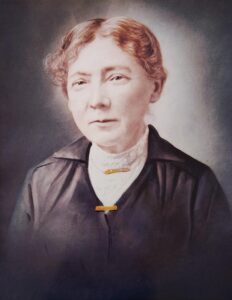
I suspect this marriage was a challenge for George as by now he had become publicly vocal about declining moral standards despite his questionable past.
Elizabeth and Joseph’s first child, Jane, was born in December 1880. Further Joseph was the known father of Eve Raynor born in 1875. If I am right about my great, great, Grandmother Ann, however, she kept calm and given all she had dealt with realised these issues were not significant in the grand scheme of things.
Emily Ewington married Henry Cole in July 1883, Ellen Ewington married Thomas Deverill in August 1883 and Mary Ann Ewington married John Deverill in May 1884. Ann and John now had just Thomas living at home a big change in a short time.
Unfortunately, this period was not entirely golden. The Tasmanian economy was in recession, and John, now 68, found managing the larger farm increasingly difficult. Joseph and Elizabeth Ewington became tenant farmers on 50 acres, but even this was not enough to save the property. In 1884, John defaulted on payments to the Crown and attempted to sell the property. The farm, described as a dairy farm containing 200 acres with various amenities, did not sell. How long the families were able to stay on the farm is unclear, but Joseph was listed as a farmer in Sassafras in early 1885. John’s health declined and he died of paralysis in March 1886 while living at Sassafras, with Joseph and Elizabeth Jane, in March 1886.
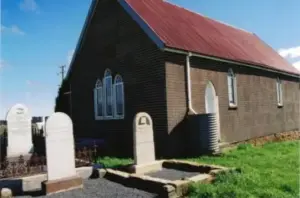
Ann in Old Age
This section is still to be written
